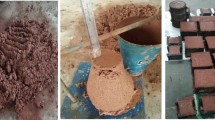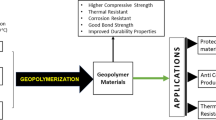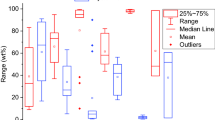Abstract
This study quantifies the results of the thermal conductivity for cement-based foam reinforced with polypropylene fibers and correlates the influence with pozzolans, porosity, moisture content, and pore parameters. Here, the mixtures were prepared for the densities range of 400–800 kg/m3 in which cement was replaced in the ratios of 10% and 20% (by weight) with fly ash, silica fume, and metakaolin. Along with pozzolan, polypropylene micro-fibers were added at the volume fraction of 0.2%. The thermal conductivity was measured variously at the hydration age of 60–210 days by using the transient plane source technique. While the porosity and the pore parameters were evaluated by using X-ray microtomography, a non-destructive technique. The results revealed that polypropylene fibers contributed to reducing the conductivity and among the three pozzolans, fly ash was the most efficient. However, the porosity increases with the inclusion of fibers but drops significantly with the addition of pozzolans, especially for lower densities mixtures. Also, it was found that D50 relates linearly with conductivity. However, based on experiment results, a modified thermal conductivity predictive model for cement-based foam reinforced with fiber was developed.











Similar content being viewed by others
References
Kearsley E, Wainwright P (2002) Ash content for optimum strength of foamed concrete. Cem Concr Res 32:241–246. https://doi.org/10.1016/s0008-8846(01)00666-4
Aldridge D (2005) Introduction to foamed concrete: what, why, how? In: Proceedings of the international conference on the use of foamed concrete in construction, University of Dundee, Scotland. vol 5, pp 1–4
Ochsner A, Murch G, Lemos M (2008) Cellular and porous materials. Wiley, Weinheim
Awang H, Mydin MAO, Roslan AF (2012) Effect of additives on mechanical and thermal properties of lightweight foamed concrete. Pelagia Res Lib Adv Appl Sci Res 3(5):3326–3338
Jones M, McCarthy A (2005) Utilising unprocessed low-lime coal fly ash in foamed concrete. Fuel 84:1398–1409. https://doi.org/10.1016/j.fuel.2004.09.030
Goual M, Bali A, Quéneudec M (1999) Effective thermal conductivity of clayey aerated concrete in the dry state: experimental results and modelling. J Phys Appl Phys 32:3041–3046. https://doi.org/10.1088/0022-3727/32/23/310
Wei S, Yiqiang C, Yunsheng Z, Jones M (2013) Characterization and simulation of microstructure and thermal properties of foamed concrete. Constr Build Mater 47:1278–1291. https://doi.org/10.1016/j.conbuildmat.2013.06.027
Samson G, Phelipot-Mardelé A, Lanos C (2016) Thermal and mechanical properties of gypsum–cement foam concrete: effects of surfactant. Eur J Environ Civ Eng 21:1–20. https://doi.org/10.1080/19648189.2016.1177601
Kamseu E, Gouloure Z, Ali B, Zekeng S, Melo U, Rossignol S et al (2015) Cumulative pore volume, pore size distribution and phases percolation in porous inorganic polymer composites: relation microstructure and effective thermal conductivity. Energy Build 88:45–56. https://doi.org/10.1016/j.enbuild.2014.11.066
Papa E, Medri V, Kpogbemabou D, Morinière V, Laumonier J, Vaccari A et al (2016) Porosity and insulating properties of silica-fume based foams. Energy Build 131:223–232. https://doi.org/10.1016/j.enbuild.2016.09.031
Cheung A, Zhu HG, Leung CKY, Lin MSW (2012) High performance cementitious materials with thermal insulation property. In: 11th international conference on concrete engineering and technology. CONCET, Putrajaya, Malaysia
Ma C, Chen B (2017) Experimental study on the preparation and properties of a novel foamed concrete based on magnesium phosphate cement. Constr Build Mater 137:160–168. https://doi.org/10.1016/j.conbuildmat.2017.01.092
Huang Z, Zhang T, Wen Z (2015) Proportioning and characterization of Portland cement-based ultra-lightweight foam concretes. Constr Build Mater 79:390–396. https://doi.org/10.1016/j.conbuildmat.2015.01.051
Batool F, Bindiganavile V (2018) Quantification of factors influencing the thermal conductivity of cement-based foam. Cement Concr Compos 91:76–86. https://doi.org/10.1016/j.cemconcomp.2018.04.015
Demirboǧa R (2003) Influence of mineral admixtures on thermal conductivity and compressive strength of mortar. Energy Build 35(2):189–192. https://doi.org/10.1016/s0378-7788(02)00052-x
Demirboğa R, Türkmen İ, Burhan-Karakoç M (2007) Thermo-mechanical properties of concrete containing high-volume mineral admixtures. Build Environ 42(1):349–354. https://doi.org/10.1016/j.buildenv.2005.08.027
Batool F (2015) Effect of microstructure on the thermal conductivity of the cement based foam, Civil Engineering Department, University of Alberta, Ph.D. Thesis
Zollo R, Hays C (1998) Engineering material properties of a fiber reinforced cellular concrete (FRCC). ACI Mater J 95:631–635. https://doi.org/10.14359/405
Ramamurthy K, Kunhanandan Nambiar E, Indu Siva Ranjani G (2009) A classification of studies on properties of foam concrete. Cement Concr Compos 31:388–396. https://doi.org/10.1016/j.cemconcomp.2009.04.006
Amran Y, Farzadnia N, Abang Ali A (2015) Properties and applications of foamed concrete; a review. Constr Build Mater 101:990–1005. https://doi.org/10.1016/j.conbuildmat.2015.10.112
Falliano D, De Domenico D, Ricciardi G, Gugliandolo E (2019) Compressive and flexural strength of fiber-reinforced foamed concrete: effect of fiber content, curing conditions and dry density. Constr Build Mater 198:479–493. https://doi.org/10.1016/j.conbuildmat.2018.11.197
Falliano D, De Domenico D, Ricciardi G, Gugliandolo E (2019) Improving the flexural capacity of extrudable foamed concrete with glass-fiber bi-directional grid reinforcement: an experimental study. Compos Struct 209:45–59. https://doi.org/10.1016/j.compstruct.2018.10.092
Dawood E, Mohammad Y, Abbas W, Mannan M (2018) Toughness, elasticity and physical properties for the evaluation of foamed concrete reinforced with hybrid fibers. Heliyon. 4:e01103. https://doi.org/10.1016/j.heliyon.2018.e01103
Ahmad M, Awang H (2012) Effect of steel and alkaline-resistance glass fibre on mechanical and durability properties of lightweight foamed concrete. Adv Mater Res 626:404–410. https://doi.org/10.4028/www.scientific.net/amr.626.404
Irawan T, Saloma, Idris Y (2019) Mechanical properties of foamed concrete with additional pineapple fiber and polypropylene fiber. J Phys: Conf Ser 1198:082018. https://doi.org/10.1088/1742-6596/1198/8/082018
Papayianni I, Milud A (2005) Production of foamed concrete with High Calcium fly ash. In: Proceedings international conference on the use of foamed concrete in construction, University of Dundee, pp 23–28
Li L, Chu S, Zen K, Zhu J, Kwan A (2018) Roles of water film thickness and fibre factor in workability of polypropylene fibre reinforced mortar. Cement Concr Compos 93:196–204. https://doi.org/10.1016/j.cemconcomp.2018.07.014
Bindiganavile V, Hoseini H (2008) Foamed concrete, developments in the formulation and reinforcement of concrete, Mindess, pp 231–256
Karahan O, Atiş C (2011) The durability properties of polypropylene fiber reinforced fly ash concrete. Mater Des 32:1044–1049. https://doi.org/10.1016/j.matdes.2010.07.011
CAN/CSA A3000 (2013) Cementitious materials compendium, Canadian Standards, 2013, Association Mississauga, Ontario, Canada
ASTM C618 (2012) Standard Specification for coal fly ash and raw or calcined natural pozzolan for use in concrete. In: ASTM international, 2012, West Conshohocken, PA
ASTM C1240 (2012) Standard specification for silica fume used in cementitious mixtures. In: ASTM international, West Conshohocken, PA
ASTM C869 (2012) Standard specification for foaming agents used in making preformed foam for cellular concrete. In: ASTM international, West Conshohocken, PA
ISO/DIS 22007-2.2, Standards, (2008)
Batool F, Bindiganavile V (2017) Air-void size distribution of cement-based foam and its effect on thermal conductivity. Construct Build Mater 149:17–28
ASTM C566 (2013) Standard test method for total evaporable moisture content of aggregate by drying. In: ASTM international, West Conshohocken, PA, 2013
ASTM C39 (2018) Standard test method for compressive strength of cylindrical concrete specimen. In: ASTM international, West Conshohocken, PA
Batool F, Bindiganavile V (2020) Fresh properties of fiber reinforced cement-based foam with Pozzolans. Iran J Sci Technol Trans Civ Eng. https://doi.org/10.1007/s40996-020-00357-1
Acknowledgements
The authors would like to thank the Natural Sciences and Engineering Research Council (NSERC-Canada), Cematrix Canada Inc, Calgary and City of Edmonton’s Drainage Services for providing financial support. The authors would also like to extend thanks to Elastizell Corporation of America, Inc for their assistance in setting up the foam generator.
Funding
Natural Sciences and Engineering Research Council (NSERC-Canada) funded this research project through its Collaborative Research and Development Grant program. Financial support and in-kind contribution from Cematrix Canada Inc, Calgary and the City of Edmonton’s Drainage Services. (The amount of fund is confidential).
Author information
Authors and Affiliations
Corresponding author
Ethics declarations
Conflict of interest
The authors declare that they have no conflict of interest.
Additional information
Publisher's Note
Springer Nature remains neutral with regard to jurisdictional claims in published maps and institutional affiliations.
Rights and permissions
About this article
Cite this article
Batool, F., Bindiganavile, V. Evaluation of thermal conductivity of cement-based foam reinforced with polypropylene fibers. Mater Struct 53, 13 (2020). https://doi.org/10.1617/s11527-020-1445-7
Received:
Accepted:
Published:
DOI: https://doi.org/10.1617/s11527-020-1445-7




